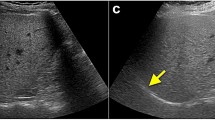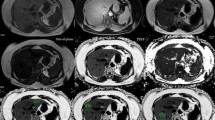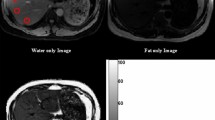Abstract
Objective
To assess the heterogeneity of liver fat deposition with MR of the liver in type-2 diabetic (T2D) patients.
Methods
We enrolled 121 consecutive T2D patients. The reference standard was 3.0-T 1H-MR spectroscopy. Hepatic steatosis was defined as liver fat content (LFC) ≥5.56 %. A triple-echo gradient-echo sequence corrected for T1 recovery and T2* decay was used to calculate LFC in left and right livers and hepatic segments. Analyses were performed using a linear mixed model.
Results
Fifty-nine (48.8 %) patients had liver steatosis, whereas 62 (51.2 %) did not. Steatosis was greater in the right than in the left liver (P < 0.0001) [mean difference: 1.32 % (range: 0.01–8.75 %)]. In seven patients (5.8 %), LFC was <5.56 % in one side of the liver, whereas it was ≥5.56 % in the other.
Steatosis of the left and right liver was heterogeneous at the segmental level in both non-steatotic (P < 0.001 and P < 0.0001 respectively) and steatotic (P < 0.0001 and P = 0.0002 respectively) patients [mean maximum difference: 3.98 % (range: 0.74–19.32 %)]. In 23 patients (19 %), LFC was <5.56 % in one segment, whereas it was ≥5.56 % in at least one other.
Conclusion
Overall, the mean segmental/lobar variability of steatosis is low. However, segmental variability can sometimes lead to a misdiagnosis.
Key Points
-
There is a need for methods quantifying steatosis over a large region.
-
Steatosis is usually greater in the right than left lobe of the liver.
-
Steatosis within both left and right hepatic lobes is segmentally heterogeneous.
-
Segmental variability of steatosis can result in misdiagnosis.




Similar content being viewed by others
References
Browning JD, Szczepaniak LS, Dobbins R et al (2004) Prevalence of hepatic steatosis in an urban population in the United States: impact of ethnicity. Hepatology 40:1387–1395
Kleiner DE, Brunt EM, Van Natta M et al (2005) Design and validation of a histological scoring system for nonalcoholic fatty liver disease. Hepatology 41:1313–1321
Merriman RB, Ferrell LD, Patti MG et al (2006) Correlation of paired liver biopsies in morbidly obese patients with suspected nonalcoholic fatty liver disease. Hepatology 44:874–880
Ratziu V, Charlotte F, Heurtier A et al (2005) Sampling variability of liver biopsy in nonalcoholic fatty liver disease. Gastroenterology 128:1898–1906
Johnson NA, Walton DW, Sachinwalla T et al (2008) Noninvasive assessment of hepatic lipid composition: Advancing understanding and management of fatty liver disorders. Hepatology 47:1513–1523
van Werven JR, Marsman HA, Nederveen AJ et al (2010) Assessment of hepatic steatosis in patients undergoing liver resection: comparison of US, CT, T1-weighted dual-echo MR imaging, and point-resolved 1H MR spectroscopy. Radiology 256:159–168
Guiu B, Petit JM, Loffroy R et al (2009) Quantification of liver fat sontent: somparison of triple-echo chemical shift gradient-echo imaging and in vivo proton MR spectroscopy. Radiology 250:95–102
Yoshimitsu K, Honda H, Kuroiwa T et al (2001) Unusual hemodynamics and pseudolesions of the noncirrhotic liver at CT. Radiographics 21:S81–S96
Pineda N, Sharma P, Xu Q, Hu X, Vos M, Martin DR (2009) Measurement of hepatic lipid: high-speed T2-corrected multiecho acquisition at 1H MR spectroscopy–a rapid and accurate technique. Radiology 252:568–576
Yokoo T, Bydder M, Hamilton G et al (2009) Nonalcoholic fatty liver disease: diagnostic and fat-grading accuracy of low-flip-angle multiecho gradient-recalled-echo MR imaging at 1.5 T. Radiology 251:67–76
Guiu B, Loffroy R, Petit JM et al (2009) Mapping of liver fat with triple-echo gradient echo imaging: validation against 3.0-T proton MR spectroscopy. Eur Radiol 19:1786–1793
Targher G, Bertolini L, Rodella S et al (2007) Nonalcoholic fatty liver disease is independently associated with an increased incidence of cardiovascular events in type 2 diabetic patients. Diabetes Care 30:2119–2121
Naressi A, Couturier C, Devos JM et al (2001) Java-based graphical user interface for the MRUI quantitation package. MAGMA 12:141–152
Szczepaniak LS, Nurenberg P, Leonard D et al (2005) Magnetic resonance spectroscopy to measure hepatic triglyceride content: prevalence of hepatic steatosis in the general population. Am J Physiol Endocrinol Metab 288:E462–E468
Kotronen A, Peltonen M, Hakkarainen A et al (2009) Prediction of non-alcoholic fatty liver disease and liver fat using metabolic and genetic factors. Gastroenterology 137:865–872
Hussain HK, Chenevert TL, Londy FJ et al (2005) Hepatic fat fraction: MR imaging for quantitative measurement and display–early experience. Radiology 237:1048–1055
Irwan R, Edens MA, Sijens PE (2008) Assessment of the variations in fat content in normal liver using a fast MR imaging method in comparison with results obtained by spectroscopic imaging. Eur Radiol 18:806–813
Lin LI (1989) A concordance correlation coefficient to evaluate reproducibility. Biometrics 45:255–268
Wieckowska A, McCullough AJ, Feldstein AE (2007) Noninvasive diagnosis and monitoring of nonalcoholic steatohepatitis: present and future. Hepatology 46:582–589
Brunt EM, Tiniakos DG (2010) Histopathology of nonalcoholic fatty liver disease. World J Gastroenterol 16:5286–5296
El-Badry AM, Breitenstein S, Jochum W et al (2009) Assessment of hepatic steatosis by expert pathologists: the end of a gold standard. Ann Surg 250:691–697
Fiorini RN, Kirtz J, Periyasamy B et al (2004) Development of an unbiased method for the estimation of liver steatosis. Clin Transplant 18:700–706
Marsman H, Matsushita T, Dierkhising R et al (2004) Assessment of donor liver steatosis: pathologist or automated software? Hum Pathol 35:430–435
Raptis DA, Fischer MA, Graf R et al (2011) MRI: the new reference standard in quantifying hepatic steatosis? Gut 61:117–127, Epub 2011 Oct 13
Brunt EM (2008) Do you see what I see? The role of quality histopathology in scientific study. Hepatology 47:771–774
Guiu B, Petit JM, Loffroy R et al (2011) Liver methylene fraction by dual- and triple-echo gradient-echo imaging at 3.0 T: Correlation with proton MR spectroscopy and estimation of robustness after SPIO administration. J Magn Reson Imaging 33:119–127
Barbaro B, Palazzoni G, Prudenzano R, Cina A, Manfredi R, Marano P (1999) Doppler sonographic assessment of functional response of the right and left portal venous branches to a meal. J Clin Ultrasound 27:75–80
Gates GF, Dore EK (1973) Streamline flow in the human portal vein. J Nucl Med 14:79–83
Yamagami T, Arai Y, Matsueda K, Inaba Y, Sueyoshi S, Takeuchi Y (1999) The cause of nontumorous defects of portal perfusion in the hepatic hilum revealed by CT during arterial portography. AJR Am J Roentgenol 172:397–402
Couinaud C (1988) The parabiliary venous system. Surg Radiol Anat 10:311–316
Chalasani N (2009) Nonalcoholic fatty liver disease liver fat score and fat equation to predict and quantitate hepatic steatosis: promising but not prime time! Gastroenterology 137:772–775
Acknowledgements
We would like to thank Philip Bastable for revision of the English language.
Author information
Authors and Affiliations
Corresponding authors
Rights and permissions
About this article
Cite this article
Capitan, V., Petit, JM., Aho, S. et al. Macroscopic heterogeneity of liver fat: an MR-based study in type-2 diabetic patients. Eur Radiol 22, 2161–2168 (2012). https://doi.org/10.1007/s00330-012-2468-4
Received:
Revised:
Accepted:
Published:
Issue Date:
DOI: https://doi.org/10.1007/s00330-012-2468-4




